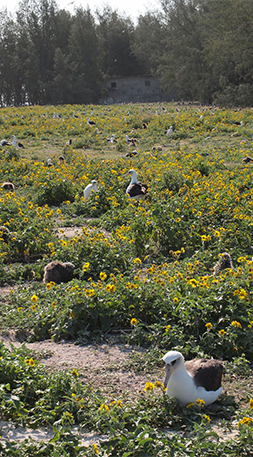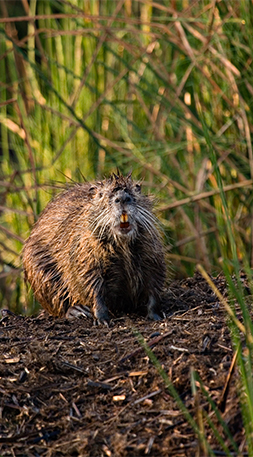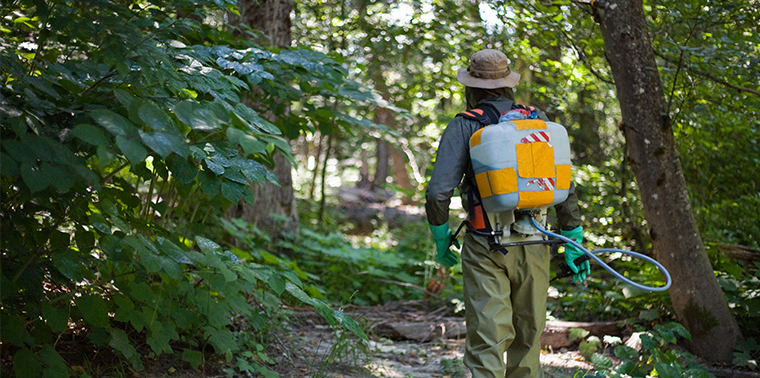September 28, 2015 — The fight continues at the site of the World War II Battle of Midway in the North Pacific. But rather than an attack by foreign forces on the U.S. Navy, this assault is by the U.S. Fish and Wildlife Service against the invasive plant Verbesina encelioides. Introduced in the 1930s, this insidious yellow aster has choked the three islands comprising the Midway Atoll National Wildlife Refuge with mats of growth that inhibit albatross nesting. For two years, staff regularly sprayed the invasive plants with herbicides. They receded, crews reintroduced native plants conducive to albatross nesting, and the endangered birds’ survival rates are increasing.
This particular battle of Midway is far from unique. Synthetic chemical poisons have been employed in conservation management around the world for decades. Conservation biologists use them to kill invasive plants, animals, insects or other invading life forms on land or in aquatic ecosystems. Such chemicals have been used for everything from eliminating invasive plants from grazed pasture as a first step in restoring Australia’s mallee shrublands to killing Guam’s invasive brown treesnake by parachute-dropping dead mice stuffed with acetaminophen to using rotenone, a pesticide listed as highly toxic to bees by the Xerces Society, to kill invasive fish from Maine to California.

Herbicides have played a vital role in reducing infestations of invasive plants that rob albatrosses of nesting grounds on Midway Atoll. Photo by Stephanie Batzer (Flickr/Creative Commons).
It’s difficult to get a handle on what kinds of chemicals are used for what purposes and in what quantities. The U.S. Environmental Protection Agency estimates annual world pesticide usage at 5.2 billion pounds in 2007 — the latest information available. That number, however, includes pesticides — herbicides and insecticides — used in agriculture, too, and the EPA does not separately track conservation usage. The U.S. Forest Service provides pesticide use summaries for national forests and grasslands on a region-by-region basis, but notes that the information “should not be interpreted as inclusive of all pesticide applications conducted by the agency, its partners, or collaborators on National Forest System lands and waters.” An unpublished study of herbicide use on public wildlands in the U.S. by University of Montana ecologist Viktoria Wagner and colleagues estimates that more than 1 million hectares (2.4 million acres) of such lands were sprayed with herbicides in the U.S. between 2007 and 2011, and more than 200 metric tons (220 tons) of herbicide active ingredients were used on these lands in 2010 alone. Various conservation organizations contacted were reluctant to discuss the issue: When asked about chemical use, The Nature Conservancy wouldn’t interview on the record. Wiley Buck, a restoration ecologist with Great River Greening, an urban conservation nonprofit, also declined. The USFWS agreed to public affairs–supervised interviews with staff, but only after vetting questions to be asked.
Many land managers minimize the use of synthetic chemicals. In 2014, as chief of the National Wildlife Refuge System, or NWRS, James Kurth (now deputy director of USFWS) issued a memo to refuge chiefs to phase out the use of neonicotinoid insecticides by January 2016, noting, “We make this decision based on a precautionary approach to our wildlife management practices and not on agricultural practices.”
Indeed, with growing concern about the unintended consequences of pesticides on humans and ecosystems alike, habitat managers are increasingly borrowing a page from agriculture, incorporating a chemical-reducing practice known as integrated pest management — IPM — into their practices.
Toolbox of Alternatives
IPM offers land managers a toolbox of alternatives to chemical pest control, such as prescribed fire, biological controls and grazing. It is increasingly the control method of choice for conservation organizations and agencies. The U.S. Department of the Interior calls the practice “a sustainable approach to managing pests by combining biological, cultural, physical, and chemical tools in a way that minimizes economic, health, and environmental risks.” The U.S. Forest Service also uses IPM and “works collaboratively with domestic and international partners to identify potential new techniques and biological control agents for invasive species control and management.”
According to Mark Cleveland, statewide management coordinator for the Minnesota Department of Natural Resources Scientific and Natural Areas — SNA — program, prevention is the first and best practice of IPM. “I try to get the message out to staff, scientists or anyone on an SNA to make sure they’re not tracking in invasive species and don’t track them out to another site,” he says. Boots, tools and all equipment are cleaned before and after site work.
The Xerces Society and the Natural Resources Conservation Service have developed an IPM guide that informs land managers how to prevent or reduce negative effects of pesticides on pollinators, such as choosing lower impact pesticides, coating fruit or other vulnerable plant parts with clay to make them harder for pests to access and using species-specific pheromones to disrupt mating. The society uses IPM to protect invertebrates and their habitat, and society IPM specialist Thelma Heidel-Baker works directly with landowners to implement habitat conservation programs. Important, she says, is “minimizing harm by being aware of risks to organisms in the area.” If insecticide must be used, for example, she recommends spraying at night when the pollinators are not out or when flowers are not in bloom. When certified organic farms convert agricultural land to conservation land, she advises solarization — using sheets of clear plastic to kill weeds before replanting a site with native species.

Wildlife managers are using a variety of nonchemical approaches to eliminate invasive nutria from the Blackwater National Wildlife Refuge on Chesapeake Bay.Photo courtesy of U.S. Department of Agriculture (Flickr/Creative Commons).
When the USFWS and public and private partners got together to eradicate nutria, a nonnative mammal, from the Blackwater National Wildlife Refuge on Chesapeake Bay, they opted not to use poisons. Instead, they used a variety of approaches to locate nutria — sending in sterile nutria with tracking collars to find the marsh nutria, placing attractively scented platforms in open water, setting out recorders to capture their sounds, and searching with dogs — so they could trap and destroy them. Since 2002, more than 13,000 nutria have been located, trapped and removed. The agencies determined that they can eliminate nutria from 120,000 acres where native plants and animals are now returning, and the program is expanding into neighboring areas.
In the Upper Mississippi River National Wildlife Refuge, nonnative weeds such as reed canary grass, crown vetch and garlic mustard appear in prairie meadows and create monocultures. To kill these weeds, refuge manager and area supervisor Sabrina Chandler sometimes uses herbicide, but she also uses mowing, grazing and pulling. “Sometimes the grazers are cows,” she says, “but if it’s a wet prairie, I might use sheep or goats to prevent soil compaction.” In remote areas, she sends in technicians and volunteers to pull the weeds. The refuge also releases alien beetles to eat invasive purple loosestrife plants without negative effects on the ecosystem. “Only a [U.S. Department of Agriculture]–approved agent biocontrol is released,” says Chandler. “The USDA does all the necessary tests for species and habitat safety before approving a biocontrol’s use in the field.”
Despite all of these efforts, infiltration of invasive species will remain persistent throughout all ecosystems, and so will the use of synthetic chemicals to control them. “We are not going to get rid of all pesticide use,” Heidel-Baker says. “It’s not going to happen.” Nevertheless, as both invasive species pervasiveness and concern about pesticide effects grow, so too, it’s likely, will the use of IPM to minimize the use of chemical controls. ![]()
Editor’s note: Julie Johnson produced this article as a participant in the Ensia Mentor Program. Her mentor for the project was Minnesota-based journalist and author Greg Breining.
Ensia shares solutions-focused stories free of charge through our online magazine and partner media. That means audiences around the world have ready access to stories that can — and do — help them shape a better future. If you value our work, please show your support today.
Yes, I'll support Ensia!

I am the proprietor of the Moby Dick Hotel and Oysterfarm. My oysterbeds were drifted on by glyphosate and imazapyr as part of the spartina eradication project in Willapa Bay. As a result I have not harvested my oysters since 2007, my oysterfarmer and I are victims of the policies that you have exposed.
In many cases, the target species is not the source of the perceived problem but merely a symptom of a change in the environment. Eradicating that species rarely addresses the underlying problem and nothing is accomplished by killing it. There are as many examples of such pointless projects as there are projects, but here is an example to make the point. Tamarisk is growing along many rivers in the Southwest because it is a tree that requires little water. It is there because water in the rivers have been diverted to irrigate agriculture and provide drinking water to urban areas. Eradicating tamarisk does not bring the water back, therefore its predecessors such as cottonwoods and willows will not return. Tamarisk is a vigorous resprouter and so herbicides are used to kill its roots and prevent its return. So, in addition to accomplishing nothing, we are poisoning our watersheds.
It’s time to question the entire concept of invasive species. In a rapidly changing climate, the concept of what “belongs here” is meaningless.
And I have to say, Million Trees, the quotations on "invasive" species just makes it clear that you don't understand ecology. Salmon habitat in the Northwest has tanked in part due to "invasive" species. Species have in fact gone extinct because of alien species competing for resources if not outright predation. Yes, invasive species are symptoms of a larger problem but since we are just beginning to understand that problem and how we might better manage it, it merits the effort to run around and put out the fires so we can save as many species as we can.
Other examples of using poison on rats and ants on islands have been huge successes as well. Look at Anacapa Island or the NW Hawaiian Islands. Herbicides and pesticides should always be used sparingly and with extreme care, but in the right situation they can be a one-time 'chemotherapy' like treatment that rids the habitat of the invasive species.